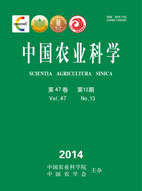-
Effect of Seed Ultra-Drying Storage on Growth and Resistance of the Medicago sativa Seedlings Affected by Alkaline Salt Stress
- HUO Ping-Hui, LI Jian-Feng, SHI Shang-Li, ZHANG Shu-Qing
-
Scientia Agricultura Sinica. 2014, 47(13):
2643-2651.
doi:10.3864/j.issn.0578-1752.2014.13.016
-
 Abstract
(
532 )
Abstract
(
532 )
 HTML
(
2 )
HTML
(
2 )
 PDF (532KB)
(
542
)
PDF (532KB)
(
542
)
 Save
Save
-
References |
Related Articles |
Metrics
【Objective】 The objective of the experiment is to study the effect of ultra-drying storage on emergence, growth and resistance of alfalfa (Medicago sativa L. cv. Longdong) seedlings derived from seeds with different moisture contents that grew under alkaline salt stress. 【Method】 Alfalfa seeds were packaged into porous nylon bags, placed into hermetic desiccator and buried in cooled silica gel that diurnally dried at 120℃ and temporally (0, 12, 24, 48, 72, 96, 120, 144 and 216 h) differently ultra-dried, then the seed moisture contents were reduced to 9.03% (CK), 7.09%, 6.93%, 6.36%, 5.72%, 5.46%, 5.18%, 4.97% and 4.59%, respectively. The ratio between seeds and silica gel was 1﹕10 (w/w). All the treated seeds were sealed in aluminum foil packages and stored in a desiccator fulfilled with dried silica gel at ambient temperature. After 1-year storage, NaHCO3 and Na2CO3 were mixed at the mole ratio of 9﹕1 to imitate the typical stress conditions, and 15 mmol•L-1 alkaline salt stresses was used to conduct the pot culture with sand using Hoagland solution. 【Result】 The results showed that no significant acceleration of seed ultra-drying storage was observed in seedling emergence, shoot height, root elongation and nodule formation. On day 30, no significant seedling emergence difference was found between 7.09%, 6.93%, 6.36%, 5.72% and 5.46% treatments and the control, while as the decrease of seed moisture contents, seedling emergence in 5.18%-4.59% treatments was found significantly lower than that of the control. On day 60, no significant difference was found in shoot height among all the treatments and the control, together with the nodule number of all treatments except the significantly low level of 4.59% treatment which was only 21.41% of the control. On day 60, root length of 7.09% and 4.97% treatments was significantly higher than the control while no significant difference was found between other seed moisture contents and the control. Moderate seed ultra-drying treatment promoted plant biomass, root volume and individual leaf number. Fresh weight of above ground and under ground parts presented a similar tendency: the value of 6.93%, 6.36%, 5.72% and 4.97% treatments was significantly higher, which were 125.08%-147.84% and 128.36%-271.11% times of the control, respectively. As for the dry weight, only 6.93% treatment was found significantly higher, which were 169.75% and 370.16% times of the control, for above ground and under ground parts, respectively, and all the other treatments were found insignificant compared with the control, except the significant low level of 4.59% treatment in above ground dry weight. On day 60, root volume of 6.93% and 6.36% treatments were 175.68% and 189.21% times of the control, and individual leaf numbers of 6.93%, 6.36% and 4.97% treatments were found significantly higher than the control. Plant root activity increased to 137.45%-199.62% in 6.93%, 6.36%, 5.72%, 5.46%, 5.18% and 4.97% treatments, plant soluble sugar content increased to 176.76%-294.20% in 5.72%, 5.46%, 5.18% and 4.97% treatments, respectively, compared with control. Chlorophyll content of all ultra-dried treatments was 137.82%-211.76% times of the control, while MDA content of all ultra-dried treatments was only 4.66 %-51.69% of the control.【Conclusion】 Moderate seed ultra-drying and storage accelerated plant biomass, root volume, leaf growth and the formation of chlorophyll, and increased root activity and seedling resistance under alkaline stress, indicating that as a kind of seed pre-treatment method, moderate seed ultra-drying promoted the seedling emergence and growth under alkaline stress conditions.









